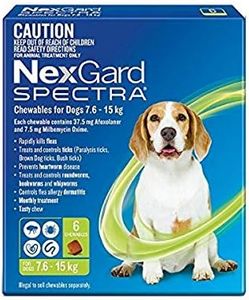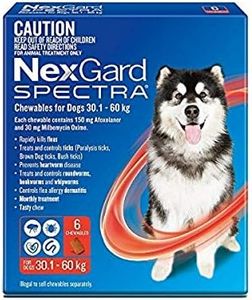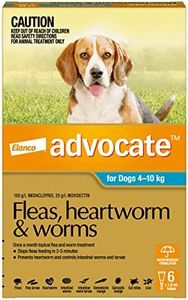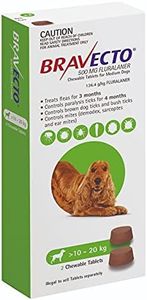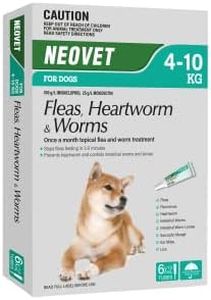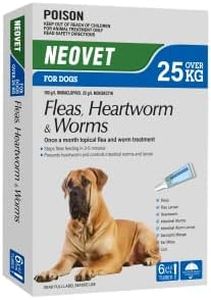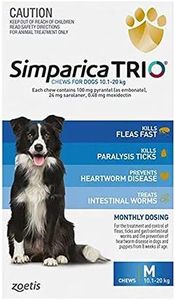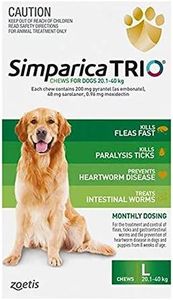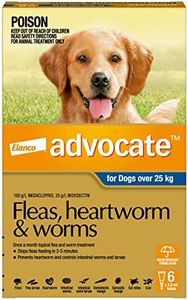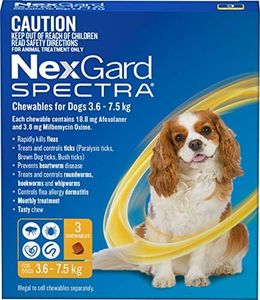We Use CookiesWe use cookies to enhance the security, performance,
functionality and for analytical and promotional activities. By continuing to browse this site you
are agreeing to our privacy policy
10 Best Flea Treatment For Dogs
From leading brands and best sellers available on the web.Buying Guide for the Best Flea Treatment For Dogs
Choosing the right flea treatment for your dog is important for the health and comfort of your pet. Fleas can cause itching, allergic reactions, and even transmit diseases, so a reliable treatment is essential. When selecting a flea product, understanding the different application methods, duration of protection, active ingredients, and dog suitability can help you find the best fit for your pet’s needs and lifestyle. Consider your dog’s habits, health, and sensitivities when making your choice.Application MethodFlea treatments come in various forms, including topical (spot-on) solutions, oral medications, collars, and sprays. The application method refers to how the treatment is given to your dog. For example, topical treatments are applied to the skin, oral medications are swallowed, collars are worn around the neck, and sprays are applied over the coat. Some methods offer convenience and are mess-free, while others may require more effort or time to apply. Choosing the right application method depends on your dog's temperament, tolerance to handling, and how easy you find it to administer treatments.
Duration of ProtectionDuration of protection indicates how long a flea treatment remains effective after it is administered. Some products offer protection for a few weeks, while others last up to several months. A longer duration means you need to treat your dog less frequently, which can be convenient for busy pet owners. However, if your dog is frequently bathed or swims often, certain long-lasting options might lose effectiveness faster. Think about your routine and choose a treatment duration that matches your management style and your dog's lifestyle.
Active IngredientsActive ingredients are the chemicals or natural substances in the treatment that actually kill or repel fleas. Common active ingredients include fipronil, imidacloprid, fluralaner, and various natural oils. The effectiveness of a treatment and its potential side effects depend on the active ingredient. Some ingredients may be better for killing adult fleas, while others target eggs and larvae, and some may have added benefits like killing ticks. If your dog has allergies or sensitivities, or if you prefer organic solutions, consider the types of active ingredients and choose accordingly.
Dog Size and Age SuitabilityMost flea treatments are formulated based on the weight and age of the dog. This is because the dosage needs to be safe and effective for your pet’s size and developmental stage. Always check the recommended minimum age and weight for a product to ensure your dog can use it safely. For puppies or small breeds, you may need specialized products, while larger or older dogs can usually use standard versions. Select a product that aligns with your dog’s current weight and age for safety and optimal results.
Water ResistanceWater resistance describes whether a flea treatment remains effective after your dog gets wet, either from swimming, bathing, or rain. Some treatments are formulated to withstand moisture, maintaining their efficacy even when your dog is frequently exposed to water. If your dog loves swimming or you bathe them often, a water-resistant treatment is essential to ensure ongoing protection. If your dog rarely gets wet, this may be less critical, but it’s still a good feature for most active pets.
Additional Parasite ProtectionSome flea treatments also protect against other parasites, such as ticks, lice, or intestinal worms. These combination products can offer broader protection in one application, which is convenient and may reduce the need for multiple medications. If you live in an area where other pests are a concern or want to simplify your pet’s preventative care routine, consider a treatment that covers more than just fleas. Match the type of protection to the specific risks in your environment.
